When Jesus the Christ commands His apostles to love God and their neighbors, and to spread the Good News of God’s Kingdom universally, He knows that means North Carolina and Brunswick County, too, even as it will take 1,500 years to occur. Another word for universal is “catholic,” and that is how people described the scope of the Christian “Way” in its early years. The Faith takes on that title officially, with a capital “C,” in the late first century in an epistle by Ignatius of Antioch. The Catholic Church continues after 2,000 years as the original Christian religion, and there are records of Catholics celebrating Mass in our vicinity as early as the 16th Century.
History notes that several hundred Hispanics and African slaves arrive in July 1526 on ships at the Cape Fear River from Santo Domingo, Hispaniola, in an attempted Spanish settlement of North Carolina. They make land at Cape Fear, and one of the ships supposedly sinks in the shoals of the river’s mouth. They build another one to replace it, and sail-on, establishing the San Miguel de Guandape Colony at a location unknown to us today. Dominican Priests Antonio Montesino and Anthony de Cervantes offer Mass for the colonists.
(Catholics believe in God, the Father Almighty, as the Creator of heaven and earth.)
Catholics keep their faith quiet around the time of the American Revolution in the 1700’s. News sources say the religion consists of only a few exiled Acadians who are in this area then. That’s because North Carolina is an established Protestant colony, and only Protestants can hold public office, constitutionally. Conversely, Maryland is a Catholic colony, so the Archdiocese of Baltimore oversees Catholicism in the 13 British colonies, under its first Catholic bishop, John Carroll.
(Catholics believe in Jesus Christ as the Father’s only begotten Son, and that He is conceived by the Holy Spirit, born of the virgin named Mary, suffers under Pontius Pilate, and dies by crucifixion on a cross. Followers bury him in an unused tomb.)
In Great Britain, the Irish suffer a devastating potato famine in the early 1880s, as well as British harassment. Irish-Catholic stonemasons and tradesmen begin migrating to the United States, with many of them moving to North Carolina. The Baltimore archdiocese regrets it cannot properly serve territories so far away. Pope Pius VII responds by creating the new Diocese of Charleston, South Carolina, which is also to serve Georgia and North Carolina. Bishop John England of Cork, Ireland takes the reins of the diocese in 1820, and spends most of the next year establishing missions in North Carolina. He starts in Wilmington, and Catholicism steadily grows in the state, fostered by immigrants of diverse nationalization working on an array of construction projects. Bishop England institutes
missionary services locally, to Forts Johnston and Caswell in these first years of the diocese. North Carolina consecrates its first Catholic Church in Washington, in 1828.
(Christ descends into hell after his death, Catholics trust, and on the third day he arises from the dead.)
Catholicism begins to take off in Brunswick County between 1840 and 1850. That’s when Father Thomas Murphy starts serving Forts Johnston, Caswell and Fisher, and Confederate troops on Smith Island (now Bald Head Island). Mary (Applewhite) Norris writes in a 1954 series of church bulletins, his parishioners include two army generals, and a Major James Reilly, who commands Fort Fisher, the last stronghold of the Confederacy, when it falls. Another churchgoer is the Oak Island lighthouse keeper, who is also a blockade runner during the Civil War. Other missionaries continue their work here, from that time on.
(Jesus ascends into heaven and sits at the right hand of His Father, Catholics believe.)
Bishop James Gibbons becomes the state’s first apostolic vicar in 1868, with a statewide Catholic population of 700 members. The Church identifies the first Catholics living in rural Brunswick County that year – some disciples in Farmer’s Turnout (now known as Maaco). State Church membership grows to 1,600 members only a few years later in 1875.
(From heaven, Jesus will come to judge the living and the dead, is the creed of Catholics.)
In the 1880’s to 1905, priests from St. Mary’s Parish in Wilmington travel to Southport and celebrate Masses in the Melarkey, Marron, Shannon and McNeil homes – all good Irish-Catholic families. Mary Norris continues in her bulletin series, Civil War veteran Major James Reilly provides land on his plantation in bucolic Farmer’s Turnout for the first Catholic Church, school and cemetery in Brunswick County. Saint Paul the Apostle Church opens its doors and becomes home to 50 parishioners. The school and cemetery follow. But as the heads of the original families die, and the descendants move away, the property lies dormant and goes up for sale at the turn of the new century. Meanwhile, internationally, there’s turmoil in the Middle East resulting in the arrival of Lebanese migrants to the state, greatly increasing the Catholic population.
Between 1924 and 1940, the Diocese of Raleigh begins service and Bishop William J. Hafey re-establishes the mission in Maaco (Farmer’s Turnout). However, there’s another Catholic Church in nearby Delco, now, and attempts to get the Parish going again are not successful. Father Frank J. Howard is pastor of the Whiteville (Columbus County) Sacred Heart Church at the time and becomes the diocesan missionary priest for Brunswick and Columbus Counties. He founds the mission churches in Southport (and Tabor City and Chadburn, which no longer exist). By 1929, the state Catholic population is 6,534 members.
Parishioners of the Sacred Heart mission in Southport celebrate Mass during the Depression at the Civilian Conservation Corps (CCC) Camp, followed by the “Blue Room” upstairs in the then Southport City Hall. The location is now Franklin Square Art Gallery. The Parish population is 20 members. About 20 miles down the road in Shallotte, the Church identifies its first three members.
In 1941, Father Howard oversees the first Sacred Heart mission church building in Southport, on a site donated by James “Gus” McNeil, serving fewer than 20 families. It is on the corner of Caswell and West Streets, and today is a private residence. Much of the lumber from the dismantled Saint Paul the Apostle Church goes into its construction, and it contains the old church’s sill and baptismal font. Japan attacks Pearl Harbor and the United States enters World War II this year. Catholic priests serve nine Coast Guard stations and Fort Caswell during the War.
With the end of the war in 1945, Bishop Vincent Waters increases evangelism and missions across the state. The Catholic population multiplies to 12,000 members. Ebullient war veterans return to their homes and spouses, and spark what will become known as the “baby boom.”
(Catholics believe in the Holy Spirit.)
1950’s – New and re-established families after the world war are burgeoning and returning to Church, lifting the state’s Catholic population to 20,060. Locally, the Military Ocean Terminal in Sunny Point opens, bringing new Catholics to Sacred Heart Church.
(Catholics believe in the Holy Catholic Church.)
Between 1960 and 1979, IBM, Carolina Power & Light, and other great companies flourish in North Carolina, bringing industrial development. The state attracts vacationers to the mountains and beaches. Retirees find the Tar Heel state a pleasing four-season alternative to more southern locations. This spurs a Catholic membership number of 38,490, and a new diocese forms in Charlotte to serve western NC. Locally, Sacred Heart Church becomes a canonical parish in 1964, attracts more parishioners, builds a Parish hall, and receives its first full-time pastor, Father Louis E. Morton.
(Catholics believe in a “communion of saints.” These are the baptized holy people of God on earth, united with the holy spirits in heaven, whom we emulate and together are one with the Father, Son and Holy Spirit.)
In 1980, Mrs. Sally Mulholland of Holden Beach hand-writes a letter to Bishop Joseph Gossman in Raleigh with signatures representing nearly 100 South Brunswick Catholic families. We are a large number of Catholics. It is such a long distance to other churches, and tourism is growing fast. Please establish a church in Shallotte! She is correct. Sacred Heart soon has 120 registered families, and the state Catholic census reports 46,691 members. Auxiliary Bishop George Lynch and the regional Catholic Dean, Father Robert F. Shea, assist the cause.
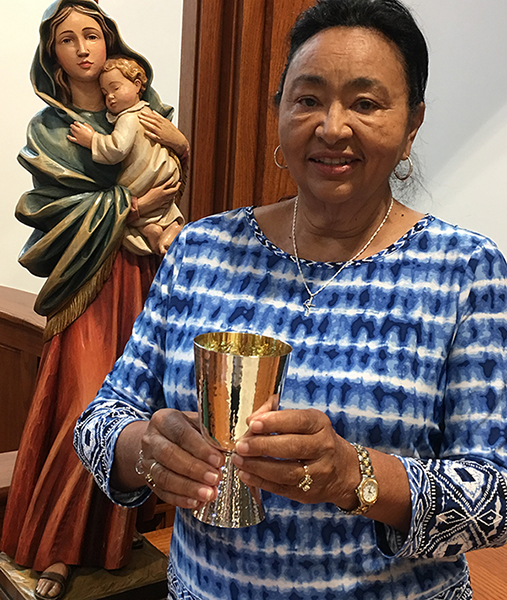 Bishop Gossman deems “South Brunswick County” a mission in 1983. Under the guidance of Father Jeffrey Ingham followed by Father John Richardson, Shallotte’s Union Primary School cafeteria becomes the site of the first Mass on May 28. The mission leases Carter’s Trading Center restaurant for 20 months, then wastes no time buying 13.2 acres on Highway 17 for their very own church. One of the first Parishioners is Agnes Galloway, whose family will no longer need to make the trek to Sacred Heart. “We joined right away, and there were about 150 of us. We were a close-knit group,” Galloway remembers. “Our Christmases were especially the most wonderful times. The Christmas plays taught the children the reason for the season. They were so excited to be part of something special.”
Bishop Gossman deems “South Brunswick County” a mission in 1983. Under the guidance of Father Jeffrey Ingham followed by Father John Richardson, Shallotte’s Union Primary School cafeteria becomes the site of the first Mass on May 28. The mission leases Carter’s Trading Center restaurant for 20 months, then wastes no time buying 13.2 acres on Highway 17 for their very own church. One of the first Parishioners is Agnes Galloway, whose family will no longer need to make the trek to Sacred Heart. “We joined right away, and there were about 150 of us. We were a close-knit group,” Galloway remembers. “Our Christmases were especially the most wonderful times. The Christmas plays taught the children the reason for the season. They were so excited to be part of something special.”
(Catholics believe in the forgiveness of sins.)
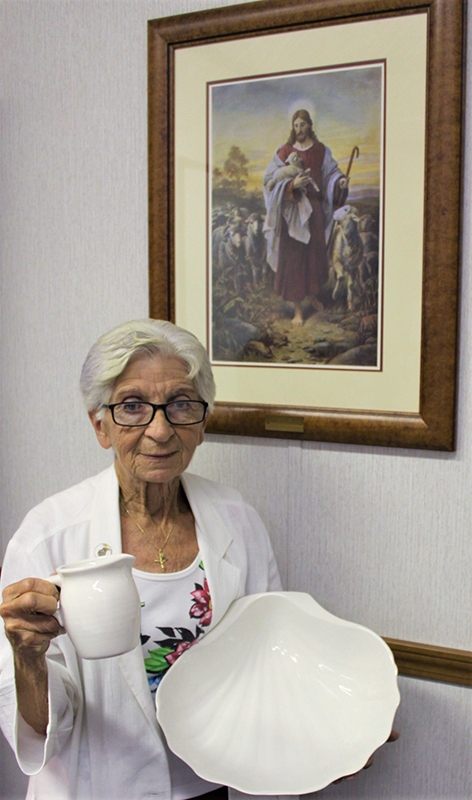 In August 1984, Parishioner Rita Canfield writes in the Brunswick Free Press that the bishop provides “full mission status under the title of St. Brendan the Navigator.” Avid boater and former U.S. Power Squadrons chaplain Father Richardson offers the name for the church after searching for a saint who had a connection with the sea. St. Brendan is the shining example he is seeking, while reading the book, “The Brendan Voyage.”
In August 1984, Parishioner Rita Canfield writes in the Brunswick Free Press that the bishop provides “full mission status under the title of St. Brendan the Navigator.” Avid boater and former U.S. Power Squadrons chaplain Father Richardson offers the name for the church after searching for a saint who had a connection with the sea. St. Brendan is the shining example he is seeking, while reading the book, “The Brendan Voyage.”
Then from 1985 to ’89, both Brunswick Parishes experience increasing growth. St. Brendan’s celebrates Mass in its half-completed $100,000 metal building church on May 4, 1985, with 110 families in the pending Parish. And on June 26, 1987, Bishop Gossman appoints Father Richardson as the first official Pastor.
Galloway recalls her daughter’s first Communion at age 7 in ’84, and her son’s Confirmation at age 13 in ’88. “Father Richardson was the Pastor, and the children loved him dearly. Bishop Gossman was with us during that time, and the children were so proud of being confirmed,” she recalls.
Sacred Heart meanwhile adds 80 families and as many as 600 visitors on Sundays. The Parish buys property on Dosher Cutoff Road for its own brand-new church, as the state Catholic population rises to 59,218.
(Catholics believe in the resurrection of the body.)
Sacred Heart dedicates its new church building on Dosher Cutoff in 1991, costing $650,000, serving 300 registered families and hundreds of vacationers each week. The state membership is up to 65,000. St. Brendan’s new pastor Father Francis Maloney reports 605 parishioners in 1993, of whom about 80 percent are retirees and “almost all are transplanted Yankees.”
On Jan. 15, 1995, the local Press reports the number of Catholics in Brunswick County triples since Mrs. Sally Mulholland presents her case to Bishop Gossman for a Shallotte-area church. On this day, the bishop presides over the new St. Brendan Church dedication, which is a 12,000 square foot red brick and wood structure costing $1.4 million. It becomes the largest church in Brunswick County, and a total of 6,000 churchgoers attend the four Easter services, says Father Maloney. His conservative estimate is St. Brendan’s will need to serve 2,500 weekly attendees by 2015. Rita Canfield beams remembering her grandson being one of the first children baptized in the expanded church, in 1996. On a sad but comforting note, she recollects the burial of one of her children, surrounded by her loving fellow parishioners and priest.
By the end of the decade, the state Catholic population is more than 700,000.
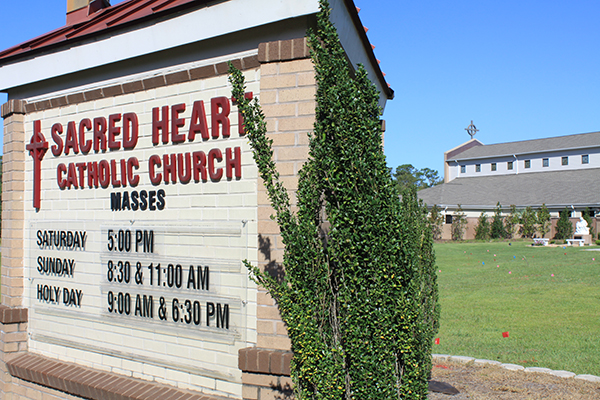 In 2003, Sacred Heart dedicates an expanded church campus, now serving 700 families and 1,500 individuals, and reaches the 1,000-family milestone in 2005. That’s a year current Parish Council member Pat Dane will never forget. His wedding day is September 25. He recalls not timing his car ride from Oak Island to the church very well that day. He is late! He is late enough that the presider, Father Doug Lawson, inquires of his bride-to-be “if she thinks I am going to make it.” With deepest apologies, the “I do’s” take place, but Dane is so remorseful he’s compelled to leave the altar after the Lord’s Prayer and shake every hand in church. This leaves his stunned bride and Father Doug just smiling and wondering what in the world is he doing!
In 2003, Sacred Heart dedicates an expanded church campus, now serving 700 families and 1,500 individuals, and reaches the 1,000-family milestone in 2005. That’s a year current Parish Council member Pat Dane will never forget. His wedding day is September 25. He recalls not timing his car ride from Oak Island to the church very well that day. He is late! He is late enough that the presider, Father Doug Lawson, inquires of his bride-to-be “if she thinks I am going to make it.” With deepest apologies, the “I do’s” take place, but Dane is so remorseful he’s compelled to leave the altar after the Lord’s Prayer and shake every hand in church. This leaves his stunned bride and Father Doug just smiling and wondering what in the world is he doing!
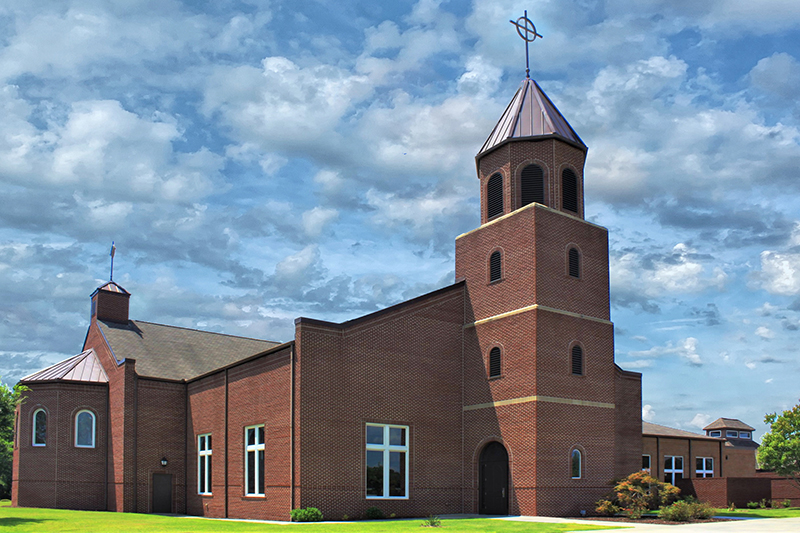 From 2007 to 2010, it’s major construction time at St. Brendan’s again, which builds its third new sanctuary since its inception. “We are splitting at the seams,” says parishioner Rusty Joy, who is the church’s only full-time employee and administrator to this day, for more than 20 years. Father Robert Ippolito is Pastor and oversees $8.5 million in new construction, and 9,000 more square feet, which includes a 75-foot-high bell tower. With 3,800 registered members, and a quarter of them Hispanic, the church will offer four weekend Masses, with one of them in Spanish. The summer average weekly attendance is 3,000, and the new church seats 1,100 people. The main entrance features a larger than life statue of Saint Brendan. Rita Canfield says Father Ippolito dons his hard hat and dutifully keeps tabs on the daily progress. The pastor trades it in for a ball-cap and lawn mower when the heavy lifting is over.
From 2007 to 2010, it’s major construction time at St. Brendan’s again, which builds its third new sanctuary since its inception. “We are splitting at the seams,” says parishioner Rusty Joy, who is the church’s only full-time employee and administrator to this day, for more than 20 years. Father Robert Ippolito is Pastor and oversees $8.5 million in new construction, and 9,000 more square feet, which includes a 75-foot-high bell tower. With 3,800 registered members, and a quarter of them Hispanic, the church will offer four weekend Masses, with one of them in Spanish. The summer average weekly attendance is 3,000, and the new church seats 1,100 people. The main entrance features a larger than life statue of Saint Brendan. Rita Canfield says Father Ippolito dons his hard hat and dutifully keeps tabs on the daily progress. The pastor trades it in for a ball-cap and lawn mower when the heavy lifting is over.
The liturgy of the Catholic Church is a remembrance of Christ’s birth, life, ministry, passion, death, resurrection and ascension, and is known as the Mass. It is very similar today to the way the earliest Christians celebrated Jesus in the first century. The first part features Old and New Testament readings, the singing of an ancient Psalm, and the Gospel. This liturgy of “The Word,” hearkens to the days of the Jewish synagogues of Jesus’ era. The highlight is the second part – The Eucharist – honoring Jesus’ command at the Last Supper that followers eat of His body and drink of His blood, in memory of Him. Knowing that anything is possible with God, the Catholic priest surrounded by the faithful asks the Father to send His Holy Spirit once again to conceive Jesus by converting simple unleavened bread wafers and wine into His body and blood. In this way, believers may honor Jesus’ requested memorial.
Today, St. Brendan the Navigator Church hosts more than 2,200 families, totaling over 5,000 registered members, with a seating capacity of 1,275 persons for each of the four weekend Masses. Hundreds more can watch on video in the Parish Hall at Christmas and Easter. These numbers are more than double Father Maloney’s 1995 estimate of need for the future. Sacred Heart Church now serves almost 1,600 families including more than 2,600 individuals and can seat as many as 750. Even more construction at both locations is in the planning stages. But the Church is not a numbers game. It’s a lifestyle. Brunswick County parishioners donate hundreds of thousands of dollars annually to local and international causes. They staff food banks, embrace immigrants studying for citizenship,
escort homeless friends to shelters, volunteer in hospitals and schools, and come to the aid of disaster victims. They visit the sick, bring scripture to prisoners, and offer the services of pro-life pregnancy centers. Sacred Heart even provides senior citizen low-income housing. There are Catholic schools, hospitals and social services ministries. And there are daily prayers for peace and healing.
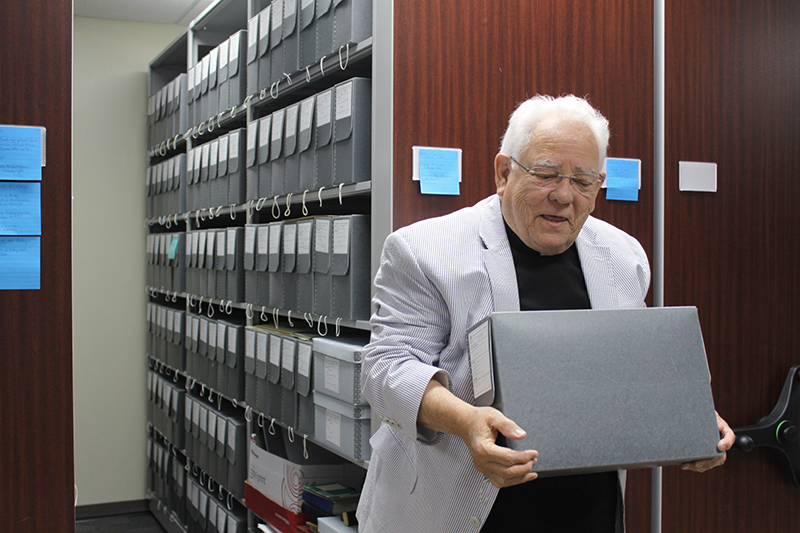 Director of the Archives of The Diocese of Raleigh, Monsignor Gerald L. Lewis, proclaims that love of God and neighbor has propelled the state’s Catholic population to 1,000,000 faithful, who in apostolic fashion spread the Good News about Jesus and His Kingdom, and celebrate the memory of the Lord by bringing Him into their lives every week in the Sacrament of the Eucharist.
Director of the Archives of The Diocese of Raleigh, Monsignor Gerald L. Lewis, proclaims that love of God and neighbor has propelled the state’s Catholic population to 1,000,000 faithful, who in apostolic fashion spread the Good News about Jesus and His Kingdom, and celebrate the memory of the Lord by bringing Him into their lives every week in the Sacrament of the Eucharist.
(Catholics believe in the life everlasting.)
Amen!
Pastoral Center Hours:
Monday - Thursday
8:30 am - 12:00 noon/
1:15 pm - 3:30 pm
Friday - 9:30-11:30